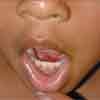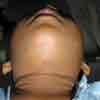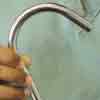Case in Point: An Unusual Injury to the Mouth
A 2-year-old boy was brought to the emergency department by his mother after he slipped and fell in the bathtub. The boy's father, who had been bathing the child when the injury occurred, reported that he had briefly turned his back while the child was attempting to drink from the hook-shaped faucet. The child had jerked his head upward when he fell, thus causing the sharp edge of the faucet tip to lodge in the soft floor of the mouth beneath the tongue. The father, in desperation, wrenched the faucet from its base and then was able to remove the tip from the child's mouth. During the removal process, the child reached up and also cut his finger on the sharp edge of the faucet.



A 2-year-old boy was brought to the emergency department by his mother after he slipped and fell in the bathtub. The boy's father, who had been bathing the child when the injury occurred, reported that he had briefly turned his back while the child was attempting to drink from the hook-shaped faucet. The child had jerked his head upward when he fell, thus causing the sharp edge of the faucet tip to lodge in the soft floor of the mouth beneath the tongue. The father, in desperation, wrenched the faucet from its base and then was able to remove the tip from the child's mouth. During the removal process, the child reached up and also cut his finger on the sharp edge of the faucet.
The child was bleeding mildly from the mouth and significantly from the left fifth finger. He had a laceration under the tongue and swelling of the submental soft tissues, with mild tenderness but no erythema (Figure 1). A circular imprint on the underside of the chin matched the outline of the faucet opening exactly (Figure 2); the surface of the skin had not been broken. The 1-cm laceration on the finger was below the distal phalangeal joint on the flexor surface; range of motion was slightly limited with flexion, secondary to pain.
The patient was given conscious sedation. No foreign body was found in the wound in the child's mouth, and the finger laceration was sutured. A radiograph of the mandible revealed stippling of the soft tissue and air in the soft tissues, consistent with a puncture wound.
About 6 hours after the injury, submental erythema had begun to develop along with a fever (temperature, 38.8ºC [102ºF]). Intravenous clindamycin was started, and the child was hospitalized for observation. Results of blood culture were negative. The complete blood cell count and differential were normal. On the second day of hospitalization, clindamycin was switched to intravenousampicillin/sulbactam for better coverage of ß-lactamase-producing organisms. This therapy was continued until discharge on day 7. A 3-day course of oral amoxicillin/clavulanate was prescribed for outpatient therapy.
During the hospitalization, social services was consulted. Consensus was reached that the injury had been self-inflicted and was unintentional.
TRAUMATIC INJURIES
Traumatic injuries are the leading cause of morbidity and mortality in children younger than 16 years.1 According to several large series, falls are the most common cause of orofacial injuries in younger children, particularly in 1 to 2 year olds.1-3 The postulated mechanism is the comparative physical instability of young children during the developmental phase that is marked by increasing independence and exploration. This mechanism certainly appears to have been a factor in this case.
In toddlers and preschoolers, injury is usually sustained during play, whereas in school-aged children, injuries during sports activities are more common. Young boys are more likely to sustain injury than girls by a ratio of about 1.6:1.1-3 Dentoalveolar trauma tops the list of craniomaxillofacial injuries; soft tissue injuries are the second most common, facial bone fractures are the least common. Among soft tissue injuries, lip lacerations--usually caused by 1 or more teeth biting into the lip during a fall--are the most common.
In this patient, only the soft structures inside the mouth were affected; the teeth and gums were spared. Penetration of the oral mucosa most commonly results when a child falls while carrying an object, such as a pen or a toy, in the mouth.4 The injury often affects the posterior soft and hard palate and the lateral pharyngeal walls.
In another case involving a child who sustained an injury while attempting to drink from a bathroom faucet, a push from a siblingresulted in a small laceration and subsequent injection of water.5 This can lead to massive edema and potential airway compromise. The child in this case did not sustain injection of water. However, his laceration was much deeper, as evidenced by the circular hematoma on the surface skin--a result of deep but not complete penetration of the dermis by the faucet.
MANAGEMENT
Usual treatment of superficial intraoral injuries consists of no more than careful surgical debridement and wound closure, if necessary.6 When infection with oral pathogens or possible necrotizing soft tissue infection is a concern--as in this case--intravenous antibiotic therapy and in-hospital observation for complications are warranted.7 Antibiot-ics should cover all potential oral pathogens, including Staphylococcus aureus, streptococci, anaerobes, and Eikenella corrodens.8
TEACHING POINT
Daily close inspection for signs of necrotizing soft tissue infection is imperative. Fever, redness, swelling, pain, and crepitus or blistering may signal a necrotizing process, which requires further surgical debridement to avoid gangrene and death. A high index of suspicion must be maintained because relatively insignificant local findings may hide more extensive subcutaneous progression to serious infection.7 In addition, immunization status needs to be ascertained to ensure adequate protection against tetanus.
References:
STRONG>REFERENCES:
1.
Gassner R, Tuli T, Hachl O, et al. Craniomaxillofacial trauma in children: a review of 3,385 cases with 6,060 injuries in 10 years.
J Oral Maxillofac Surg.
2004;62:399-407.
2.
O'Neil DW, Clark MV, Lowe JW, Harrington MS. Oral trauma in children: a hospital survey.
Oral Surg Oral Med Oral Pathol.
1989;68:691-696.
3.
Gordy FM, Eklund NP, DeBall S. Oral trauma in an urban emergency department.
J Dent Child (Chic).
2004;71:14-16.
4.
Banks K, Merlino PG. Minor oral injuries in children.
Mt Sinai J Med.
1998;65:333-342.
5.
Duplechain JK, Espinola T, Miller RH. Water spout injection into the neck.
Arch Otolaryngol Head Neck Surg.
1993;119:237-238.
6.
Goldberg MH. Antibiotics and oral and oral- cutaneous lacerations.
J Oral Surg Anesth Hosp Dent Serv.
1965;23:117-122.
7.
McMahon J, Lowe T, Koppel DA. Necrotizing soft tissue infections of the head and neck: case reports and literature review.
Oral Surg Oral Med Oral Pathol Oral Radiol Endod.
2003;95:30-37.
8.
Mollitt DL. Infection control: avoiding the inevitable.
Surg Clin N Am.
2002;82:365-378.
Recognize & Refer: Hemangiomas in pediatrics
July 17th 2019Contemporary Pediatrics sits down exclusively with Sheila Fallon Friedlander, MD, a professor dermatology and pediatrics, to discuss the one key condition for which she believes community pediatricians should be especially aware-hemangiomas.